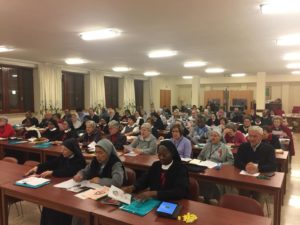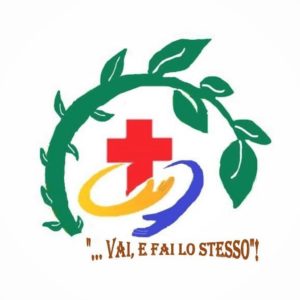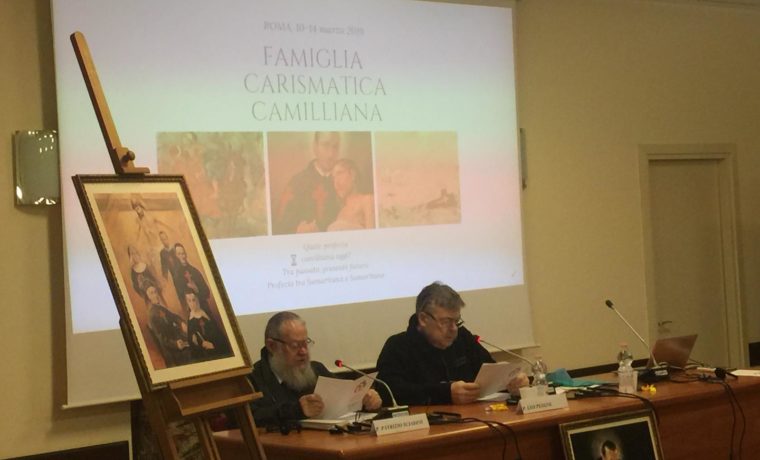Fr. Leo PESSINI
 WHICH CAMILLIAN PROPHECY TODAY? BETWEEN THE PAST…THE PRESENT…AND THE FUTURE. ProPHECY…BETWEEN THE SAMARITAN AND THE SAMARITAN WOMAN
WHICH CAMILLIAN PROPHECY TODAY? BETWEEN THE PAST…THE PRESENT…AND THE FUTURE. ProPHECY…BETWEEN THE SAMARITAN AND THE SAMARITAN WOMAN
‘Charisms are not entrusted to an institution or a group for safekeeping; rather they are gifts of the Spirit integrated into the body of the Church, drawn to the centre which is Christ’.
Pope Francis
‘Indeed, around each religious family, every Society of Apostolic Life and every Secular Institute, there is a larger family, a “charismatic family”, which includes a number of Institutes which identify with the same charism, and especially lay faithful who feel called, precisely as lay persons, to share in the same charismatic reality’.
Apostolic letter of the Holy Father Francis to all consecrated people on the occasion of the Year of Consecrated Life, III, 1
‘Charismatic Families are qualified groups of reference in the Church. Every Charismatic Family makes contemporary the gift of the Spirit with new methods and new strategies. We are never alone: our Founders and Foundresses are always with us and guide us on the journey of the inexhaustible fruitfulness of faith in the Risen Lord, the authentic gift to be contemplated, to be lived and to be borne witness to…We hope that Charismatic Families can be a prophetic witness to communion, joy and hope in service to the Kingdom of God’
Document of the Association AMCG – Charismatic Families: Journeying towards Communion. Charismatic Families in Dialogue. Planning for 2017-2020
On behalf of the Ministers of the Sick (Camillians), I offer our welcome to all those taking part in this historic event of an inter-Congregational character: this meeting of the Camillian Charismatic Family which brings together all the original expressions in institutionalised (religious and lay) form that down the centuries have drawn inspiration from St. Camillus de Lellis, his charism and his spirituality.
We constitute eight expressions of the Camillian charism which is so deeply human, evangelical, of increasing contemporary relevance, and above all else very necessary in today’s world.
- A male Order: the Ministers of the Sick (Camillians).
- Three female Congregations:
The Daughters of Saint Camillus (the Blessed Luigi Tezza and the Blessed Giuseppina Vaninni).
The women Ministers of the Sick of Saint Camillus (the Blessed Maria Domenica Brun Barbantini).
The Handmaidens of the Incarnation (Fr. Primo Fiocchi)
- Three secular female Institutes:
The women Missionaries of the Sick – Christ our Hope (Germana Summaruga).
Stella Maris (Guarulhos – SP – Brazil.)
Kamillianischen Schwestern – the Camillian Sisters (Fr. Calisto Vendrame and Heidi).
- A lay organisation connected with the Camillians:
The Lay Camillian Family (LCF).
 All of us taking part in this meeting were chosen for the thorny evangelic ministry ‘of the exercise and service of authority’ together with our fellow religious as Superior Generals, members of General Consultas and Councils, and presidents of our Congregations, Institutes and/or organisations.
All of us taking part in this meeting were chosen for the thorny evangelic ministry ‘of the exercise and service of authority’ together with our fellow religious as Superior Generals, members of General Consultas and Councils, and presidents of our Congregations, Institutes and/or organisations.
We have gathered together around a fundamental question about the future of the Camillian charism: Which Camillian prophecy today? Between the past…the present…and the future. Prophecy…between the Samaritan and the Samaritan woman.
The central word in this subject is PROPHECY. What do we mean by prophecy today? Fr. Amedeo Cencini observes: ‘Prophecy is not only, and not essentially, prefiguring a future (which is perhaps unprecedented and surprising) that will take place despite everything because it is endowed with a marvellous force that is stronger than our calculations. Prophets do not necessarily unveil the future – they unveil the truth. For this reason, prophecy is always also provocation that invites us to read history with an outlook on history, on the past and on the present as a whole, certainly as regards essential strategic points. Prophecy opens to the future but also explains the past; it is projected towards tomorrow but it is founded in memory. It is specifically thanks to this rooting in the past, correctly understood and discovered in its deepest meaning, that makes us perceive the direction to be placed on the future’.[1]
For many of our Institutes, which in a short time will celebrate their assemblies and/or General Chapters, the contents of this meeting will certainly be a useful help in the drawing up of the lineamenta, and an instrument of work and thought, with a view to the decisions about the present and the future of our Institutes. Beyond this fundamental objective, as regards other goals it will be a valuable experience of inter-Congregational fraternal being together, as a well as a strong moment of ongoing formation on the pathways of our consecrated lives.
In our Constitution and our General Statutes we find encouragement, and the invitation, to meet and to establish ‘relations of fraternity and cooperation’.
‘Our communities cultivate relations of fraternity and cooperation with the lay Congregations and Institutes inspired by the Camillian charism (GS 19).
‘Our religious value the presence and action of members of other religious Institutes who carry out their ministry in health-care and socio-health-care institutions, working with them in projects for formation and pastoral care’ (GS 20).
‘Mutual cooperation is promoted between ourselves and lay people – whether in associations or not – in relation to activities whose aims are shared by us, and in particular those connected with the world of health’ (GS 21).
‘Our religious cooperate diligently and generously with lay personnel, showing themselves open to interdisciplinary cooperation, respecting their professional competence, their experience and their personal witness as sources of inspiration and learning, and setting an example to them, from a professional point of view as well’ (GS 22).
We read as follows in the Camillian Project for a faithful and creative life: challenges and opportunities (2014-2020):
‘The Lay Camillian Family (LCF), a work of our Order, and as such recognised by all of us, is a living sign of concrete cooperation with lay people’ (Camillian Project for a faithful and creative life: challenges and opportunities, 3.1).
‘Lay people are a valuable resource given that they can act with efficacy in the processes involving the revitalisation of the Order. Their presence must not be interpreted solely in the sense of replacing religious who are absent because of age or numbers in the various functions of service in our works or in ministry in general. Rather, it is necessary to listen above all else to their need for fraternal welcome, for a sharing of our charism and our spirituality. Our communities must remain open so that lay people as well can offer their competent contribution in fields that have hitherto not been shared very much, such as social communication, the promotion of vocations, and initial and ongoing formation’ (Camillian Project for a faithful and creative life: challenges and opportunities, 3.1).
[1] Amedeo CENCINI, Abbracciare il futuro con speranza. Il domani della vita consacrata (Paoline, Milan, 2018), p. 22.














Camillians on Facebook
Camillians on Twitter
Camillians on Instagram